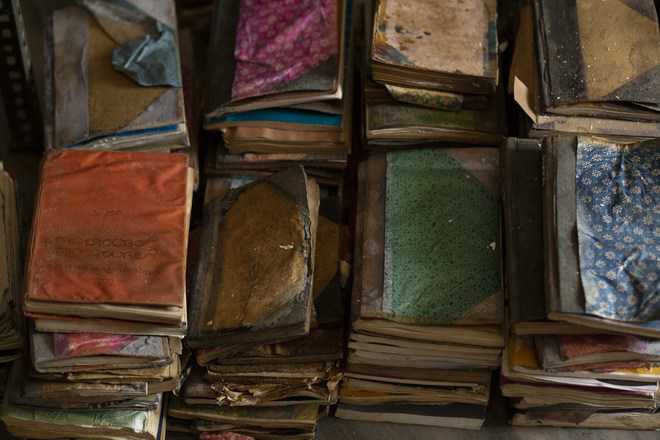
The Pelagic Tracts photoprint. Shubigi Rao’s piece created for KMB 2018
Vandana Aggarwal
Last time, Shubigi Rao attended Kochi Muziris Biennale as a participant. Next December, she will be the curator of the festival. In scale and reputation, the KMB is definitely the biggest, most well-known international visual arts event that India hosts. As the first international curator, Shubigi was picked for her “exceptional acumen and inventive sensibilities.”
A multimedia artist, Singapore-based Shubigi says, “I am more curious about the world than myself, as the former holds more fascination for me than the latter”. Her work, however, is anything but boring. Shubigi is not just a visual artist but also a theorist and a writer. Her varied interests encompass the study of diverse subjects like neuroscience, archaeology, libraries, violence, natural history and art theories. And her work incorporates multi-layered installations, comprising drawings, handmade books, pseudo-science machinery, metaphysical puzzles, and even garbage. “I am not a medium centred artist,” she elaborates “and that is why my work keeps adapting and changing.”
Since 2014 Shubigi has been working on a 10-year project, ‘Pulp: A Short Biography of the Banished Book'. This five-volume series, first two of which have been published, comprises of books, artworks and films in an attempt to put together a narrative of library destruction and censorship.
Her large body of multidisciplinary work has been displayed at prestigious events all over the world. As the only artist from Singapore to showcase her work at Kochi Muziris Biennale (KMB) 2018, she created a semi-fictional history of smuggled texts and ideas using letters and records to discuss the topic of displacement and cross-cultural experience. In scale and reputation, the KMB is definitely the biggest, most well-known international visual arts event that India hosts. As the first international curator to have been chosen to helm the fifth edition of the KMB that will take place in December next year, Shubigi was picked for her, “exceptional acumen and inventive sensibilities.”
Excerpts from an interview:
What makes KMB distinctive?
KMB’s uniqueness lies in the fact that it is a people’s Biennale. In Kochi everyone is proud of it; they talk about it, discuss it and feel a sense of connection to it. Other biennales don’t always have that local connect or context. The ethos is still local in many ways, and it is a very homegrown enterprise while still being an internationally recognised event. Since the time it started in 2012, it has been artist-led. Artists work quite differently when they create frameworks for other artistic practices.
KMB has also been a significant platform for young people, who otherwise may not have been able to break into the art scene. It gives them exposure to the ideas and works of artists from around the world, and opportunities not just to contextualise their work within global practice, but to also experience different media, ways of working, and thinking.
What are your plans for KMB 2020?
As I meet and understand artists and encounter a range of artists, I will be looking out for moments of confluence and divergence in practice and idea... I am looking at different regions of the world, the cultural interplay between them and the way they talk to each other through art, music, theatre and other art forms. I would also like to bring out the shared history of South and Southeast Asia, which is not as evident in contemporary cultural exchange.
Artists who have an artistic fidelity to their ideas and contexts appeal to me. It is important to note that a biennale is not the perspective of a single person. It is a place of convergence, of community, where multiple perspectives and forms co-exist. My responsibility is to give this community form and bring different artistic practices into the same sphere.
What are the challenges that you expect to face?
An event of this magnitude entails a lot of thinking, planning, and prioritising. It may seem overwhelming at times, but this also motivates and enthuses me. It’s the unpredictability of the whole enterprise and the magic that it brings that is so exciting. All this is possible because of a whole eco-system, of people, of goodwill, and of collaboration. There are a lot of moving parts, each supporting the other to make it happen.
I believe art is a familiar and crucial form of non-verbal communication. Where language fails, art often fills the gap. I will, therefore, be drawing on my ability to listen to people, to understand their stories with empathy, and to retain their original contexts within the common space of the Biennale.



























